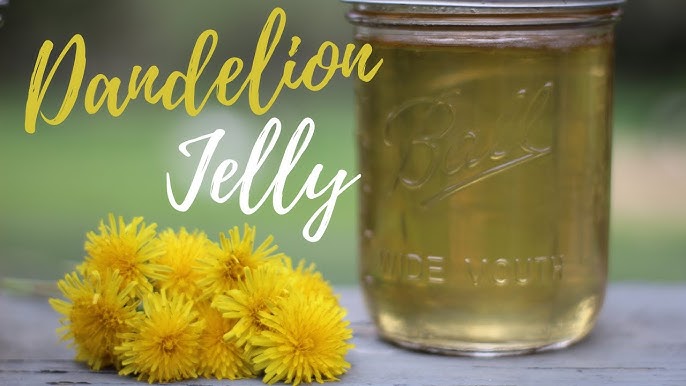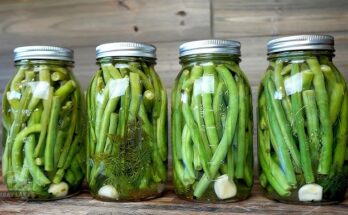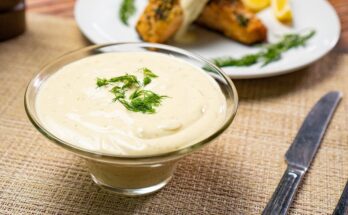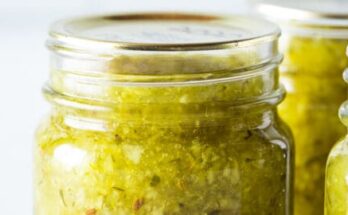Dandelion Jelly Recipe: Have you ever walked past a field of blooming dandelions and wondered if there’s more to them than just being “weeds”? Spoiler alert: there is. These bright yellow flowers can be turned into a sweet, floral, honey-like jelly that’s not only delicious but also surprisingly easy to make. Dandelion jelly is a wonderful way to bring a little sunshine to your breakfast table all year long. Whether you’re a seasoned canner or a complete beginner, this guide will walk you through every single step—from plucking those blossoms to popping sealed jars into your pantry.
This isn’t your average jam; it’s a conversation starter, a homemade gift, and a reminder that nature often hides the most unexpected treasures. Let’s dive in!
What is Dandelion Jelly?
Dandelion jelly is a sweet, translucent spread made from the petals of dandelion flowers. Think of it like honey’s floral cousin—it’s golden, smooth, and has a subtle flavor that hints at sunshine, chamomile, and spring meadows. It’s made by steeping the yellow petals in hot water to make a tea, then cooking that liquid down with lemon juice, sugar, and pectin until it becomes a beautifully set jelly.
It may sound unusual, but this jelly has been made for generations in rural homesteads and by foragers who appreciate every bit of what the earth offers. It’s not only tasty on toast or biscuits but also looks stunning in clear glass jars—golden and glowing, like liquid sunshine.
Why You’ll Love This Jelly
There are a ton of reasons to fall in love with dandelion jelly. First, it’s 100% homemade and all-natural. If you’re into foraging or just looking for new ways to use the plants around you, this is the perfect recipe. It’s also free of artificial additives and made with just a handful of simple ingredients. The flavor is delicate, slightly floral, and not overpowering—perfect for those who love lighter fruit spreads.
Another bonus? You’ll impress the heck out of your friends and family when you tell them you made jelly from weeds. Seriously. It’s a great DIY project, especially in spring when dandelions are everywhere. Plus, it makes an amazing homemade gift.
When and Where to Harvest Dandelions
Timing is everything. You want to pick your dandelions during mid to late morning on a sunny day, ideally when the flowers are fully open. This is when they’re the freshest and most flavorful. Avoid picking them after rain or on overcast days when the petals are likely closed or soggy.
As for location, go somewhere clean—avoid areas near busy roads, polluted sites, or places sprayed with pesticides or weed killers. Your backyard (if untreated) or a pesticide-free field is ideal. Always leave a few behind for the bees!
Important Tips for Picking Dandelions Safely
Picking dandelions sounds simple, but there are a few things you need to know:
- Avoid contaminated areas. Never pick from roadsides, pet potty areas, or chemically treated lawns.
- Harvest ethically. Take only what you need. Dandelions are important pollinators for bees early in the season.
- Use only the petals. The green parts (sepals) can be bitter. We’ll go over how to remove them properly soon.
- Double-check your flowers. Make sure they’re actually dandelions—not lookalikes like catsear or hawkweed.
Once harvested, store your flowers in a breathable container like a paper bag or bowl—not plastic—so they don’t wilt or sweat.
Ingredients You’ll Need
You don’t need a long grocery list to make this jelly. In fact, it’s beautifully simple.
Here’s what you’ll need:
- 4 cups dandelion petals (just the yellow parts)
- 4 cups water
- 2 tablespoons lemon juice (fresh is best, bottled works too)
- 1 box pectin (like Sure-Jell or Ball’s low-sugar pectin)
- 4 cups sugar
Optional Add-ins:
- A slice of lemon rind (for extra brightness)
- A small piece of ginger (for a zingy twist)
- A pinch of turmeric (enhances color)
Tools You’ll Need in the Kitchen
Making jelly doesn’t require fancy tools, but having the right ones will make life easier:
- Large saucepan or pot
- Fine mesh strainer or cheesecloth
- Measuring cups and spoons
- Mason jars with lids (half-pint or 8oz jars work great)
- Jar lifter or tongs
- Funnel (for easy pouring)
- Canning pot or large pot with a rack (for water bath processing)
- Ladle
Prepping Your Dandelions – The Right Way
This part is a bit tedious—but totally worth it. First, rinse your dandelions gently to remove bugs or dirt. Then comes the slightly time-consuming part: separating the yellow petals from the green base. The green parts are bitter and will ruin the flavor of your jelly.
To remove the petals:
- Hold the flower between your fingers.
- Use scissors or your fingernails to snip or pinch off just the yellow part.
- Try not to get any green parts in the mix.
This step might take 20–30 minutes for a batch, so get comfy and maybe put on a podcast. You’ll end up with a fluffy, golden pile of petals that smell faintly like honey and sunshine.
Making Dandelion Tea – The Flavor Base
Once your petals are prepped, it’s time to make the base of your jelly: dandelion tea. This infusion pulls all the delicate floral flavor out of the petals and into the water.
Here’s how to do it:
- In a medium pot, combine 4 cups of dandelion petals with 4 cups of water.
- Bring to a gentle boil, then reduce heat and simmer for about 5–10 minutes.
- Remove from heat and let it steep for several hours or overnight. The longer it steeps, the deeper the flavor.
Once steeped, strain the tea through a fine mesh strainer, cheesecloth, or even a clean tea towel. Squeeze every last drop from the petals. You should end up with 3 to 4 cups of bright golden liquid. That’s your jelly base!
Step-by-Step Guide to Making Dandelion Jelly
Now that you’ve got your beautiful golden dandelion tea ready, let’s get into the exciting part—making the jelly! This is where the magic happens and you transform a handful of flowers into jars of golden deliciousness.
Step 1: Prepare Your Workspace and Sterilize Jars
Before you start cooking, prep everything. Sterilize your jars and lids by boiling them in water for at least 10 minutes or running them through the dishwasher on the sanitize setting. Set them on a clean towel to dry while you cook the jelly.
Pro tip: Have a damp towel handy to wipe jar rims later, and keep your funnel, ladle, and jar lifter close by for easy access.
Step 2: Measure Out Your Dandelion Tea
Pour 3 to 4 cups of your strained dandelion tea into a large saucepan. If you ended up with a bit more or less, that’s okay, but try to keep it close to 4 cups for the recipe to set correctly.
Add 2 tablespoons of lemon juice to the pot. This not only balances the flavor but also ensures the jelly is acidic enough for safe preserving.
Step 3: Add the Pectin
Stir in 1 box of powdered pectin (such as Sure-Jell). Mix well before applying heat. This will help it dissolve evenly and prevent lumps. Now, turn on the heat to medium-high and bring the mixture to a rolling boil, stirring constantly.
A rolling boil means the bubbles don’t stop even when you’re stirring—it’s crucial to hit this point so the pectin can activate.
Step 4: Stir in the Sugar
Once your mixture is boiling hard, dump in 4 cups of granulated sugar all at once. Stir continuously to dissolve it. The mixture may foam a bit—don’t worry, that’s normal.
Bring everything back to a full rolling boil. Once it hits that point again, boil for 1–2 minutes while stirring constantly. This is when the jelly starts to take shape.
If you want to reduce foam, you can add a tiny bit of butter (about 1/2 teaspoon) at this stage.
Step 5: Test for Doneness
You can do a “gel test” by dropping a small spoonful of jelly onto a cold plate. Let it sit for a few seconds, then run your finger through it. If it wrinkles or holds its shape, you’re good to go!
No wrinkle? Boil for another 30 seconds and try again.
Step 6: Fill the Jars
Once your jelly passes the test, remove it from heat. Carefully ladle the hot jelly into your sterilized jars using a funnel to keep the rims clean. Leave 1/4-inch headspace at the top.
Wipe the rims with a clean damp cloth, place the lids on top, and screw the bands on just fingertip-tight. Don’t over-tighten.
Water Bath Canning Method for Jelly
To ensure your jelly is shelf-stable, process the jars in a boiling water bath:
- Place your jars into a large canning pot with a rack at the bottom.
- Make sure the jars are covered with at least 1–2 inches of water.
- Bring to a rolling boil and process for 10 minutes (add 5 extra minutes if you’re at a high altitude).
- Carefully remove the jars and set them on a towel to cool undisturbed for 12–24 hours.
You’ll hear the satisfying pop as the lids seal. Once cooled, check the seals by pressing the center of each lid. If it doesn’t move, you’re sealed and ready!
How to Tell If Your Jelly Has Set Properly
It can take a full 24 hours for jelly to fully set, so don’t panic if it looks runny right away. Here’s how to know if it worked:
- The jelly should wobble slightly but not slosh.
- If you tilt the jar, it shouldn’t pour like syrup.
- Still liquid after 24 hours? No worries—you can reprocess it with a bit more pectin, or use it as a dandelion syrup (great for pancakes!).
Creative Ways to Use Dandelion Jelly
This jelly is way more versatile than you might think. Here are some creative ways to enjoy it:
- Spread on toast, biscuits, muffins, or cornbread
- Glaze over grilled chicken, pork, or salmon
- Swirl into yogurt or oatmeal
- Use as a filling for thumbprint cookies
- Serve with cheese on a charcuterie board
- Drizzle over pancakes or waffles
- Mix into cocktails or mocktails
Its flavor pairs beautifully with citrus, ginger, honey, and even mild cheeses like brie or goat cheese.
Storage Tips: How Long Does Dandelion Jelly Last?
If processed properly and stored in a cool, dark place, sealed jars of dandelion jelly will last up to 1 year on the shelf. Once opened, keep it in the fridge and use it within 3–4 weeks.
If you skip the canning step and just refrigerate the jars, aim to use the jelly within 1 month. You can also freeze it (in freezer-safe containers) for up to 6 months.
Always check for signs of spoilage like off smell, mold, or discoloration before using.
Common Mistakes to Avoid
- Using flowers with green parts: This makes the jelly bitter.
- Not measuring ingredients correctly: Especially sugar and pectin, which affect how the jelly sets.
- Not reaching a rolling boil: This will prevent proper gelling.
- Skipping the canning step: If you want shelf-stable jelly, you must process it.
- Using treated flowers: Never use dandelions that may have been sprayed with chemicals.
Health Benefits of Dandelions
Dandelions are surprisingly nutritious. While the jelly is more about taste than health, the petals do bring in antioxidants and trace vitamins like A and C. In folk medicine, dandelions have been used to support digestion, liver health, and as a gentle diuretic.
Even though sugar levels are high in jelly, using dandelion flowers adds a natural, herbal boost that you won’t find in store-bought spreads.
FAQs about Dandelion Jelly Recipe
1. Can I use dried dandelion petals?
Fresh petals are best for flavor and color, but if dried is all you have, steep them longer and double the amount.
2. How long does dandelion jelly last unopened?
Properly canned jelly lasts up to 1 year in a cool, dark pantry.
3. Why is my jelly runny?
It may not have boiled long enough, or you didn’t use enough pectin. Let it sit 24 hours before deciding to reprocess.
4. Can I make this recipe without pectin?
Yes, but you’ll need to cook it longer and possibly add apple or lemon peels, which contain natural pectin.
5. Does dandelion jelly taste like honey?
Yes, surprisingly! It has a light, floral sweetness very similar to honey, especially if you add a bit of lemon or vanilla.
Final Thoughts
Dandelion jelly is one of those old-school recipes that feels like magic. You take something humble and overlooked—flowers most people mow down—and turn it into something beautiful, unique, and delicious. It’s a sweet reminder that sometimes, the best ingredients are right under our noses.
Whether you make it as a fun springtime activity, a gift for loved ones, or a new pantry staple, this jelly is sure to impress. Once you try it, it just might become your favorite new tradition every spring.



